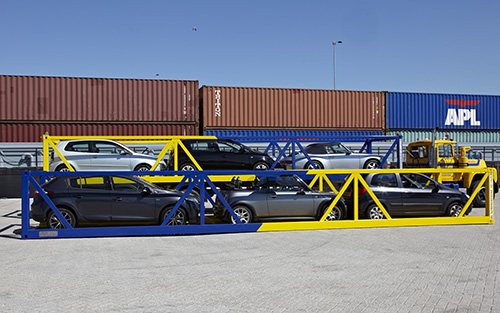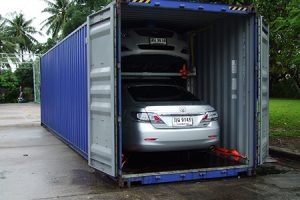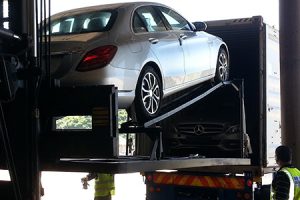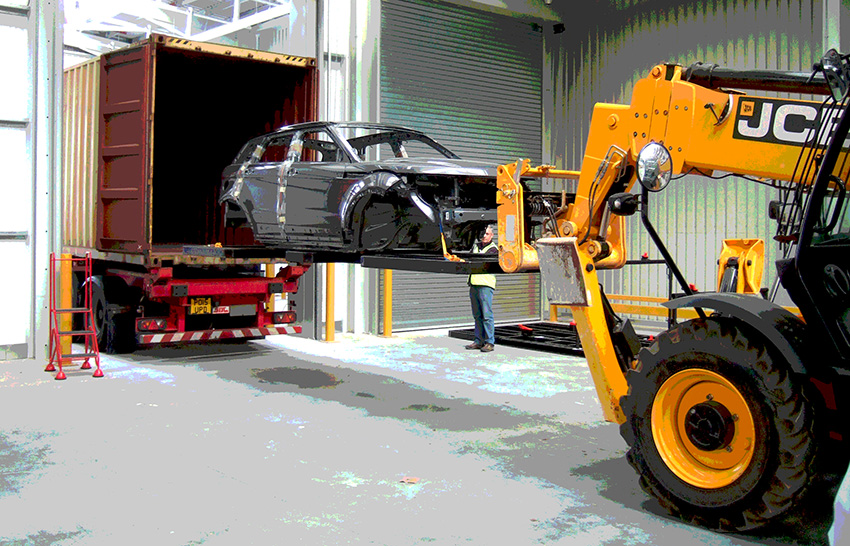Suppliers of car container equipment are gaining ground by providing fast, flexible shipping options in specific global markets
In this story...
However, the market for containerised vehicle logistics is gaining ground, thanks in part to its flexibility and speed in shipping to certain markets, its versatility across transport modes, as well as its declining price. A number of rack, cassette and loading systems have also simplified the loading and unloading process in many instances, helping containerised car shipments to grow in certain segments.
Rutger Noorlander, commercial manager for Netherlands-based Unit 45, which offers a speciality frame for moving vehicles, claims that containerised vehicle transport sales rose by around 20% in the first half of 2016 compared to the year before.
As ro-ro carriers tend to be equipped to supply large, high-volume markets, their service to smaller markets is often far less frequent than container lines. Liner services may therefore reduce the lead time for smaller shipments because of their broader service options.
Containerised shipping has also become less expensive, thanks largely to problems in the wider carrier market. Richard Cox, chief executive of Kar-Tainer International, which provides car-holding cassettes, points out that freight rates have been dropping because of an over-abundance of container vessels. “For example, from Europe to the Far East, freight costs are less than one-half compared to one year ago,” says Cox, whose customers on such routes include Daimler and BMW.

Another driver of growth, at least among a number of rack and cassette manufacturers, [sta_anchor id="1"]has been the potential to move semi-knockdown kit (SKD) bodies in specially equipped containers. Companies such as Trans-Rack International, Kar-Tainer and Unit 45 have extended services or adapted equipment to handle a number of such trade lanes.
Racking them upAmong the largest suppliers of containerised vehicle shipping equipment is UK-based Trans-Rak, which offers its R-Rak system, a specialised, removable rack that fits into any high-cube container.
Paul Donaldson, managing director, says that besides holding two vehicles per 20ft container and four per 40ft one, the R-Rak accommodates six vehicles per 45ft container and six larger vehicles in a 53ft unit. The R-Rak packs up into a small pod which can be relocated, fitting up to 60 pods into a 40ft high-cube container.
The R-Rak is used across a number of logistics providers and carmakers on a number of global export routes, as well as increasingly within and across vehicle flows in a number of Asian countries.
Another method is a cassette-based system, such as the one that Kar-Tainer offers. For Kar-Tainer, all vehicles are loaded onto systems externally, with cassettes loaded and pre-staged outside the container, says Richard Cox. It also typically holds 3-4 vehicles, depending on their size. As with R-Raks, the cassettes are not attached to the container, so they can be used to return other freight. For every 10-15 loaded containers shipped, one container is returned with Kar-Tainer equipment.
Another racking system on the market is Unit 45’s Vucaframe, which fits the entire shape of a container. Cars are loaded into the frame, which is then loaded into the container; it is designed especially to be flexible with multimodal transport.
Vucaframe offers four racks with gooseneck floors – recesses in the floor at each front end that allow the container to lie lower – and more recently flat floors as well; they are 40ft or 45ft in length and either 1,500mm or 1,700mm in height. Noorlander says that these sizes can handle more than 75% of all cars currently in production. He adds that the equipment allows for much greater storage capacity at compounds compared to that of other systems because the Vucaframe can be stacked up to seven high.
"[The use of the R-Rak system in shipping to the Philippines] eliminates several handling points, thus reducing damage and lead time. The result is faster and more accurate arrival times. Customers can also use our web-based VIN-level tracking and exception management tool in order to monitor their shipments." - Jereon van Oekel, APL Logistics
Noorlander points out that one of the differences between Vucaframe and Trans-Rak is that with Trans-[sta_anchor id="2"]Rak, cars on the upper deck must be angled, and lashed from underneath, whereas with Vucaframe, the lashing is done outside of the frame. A disadvantage of the gooseneck floor, however, is less flexibility in return cargo options, though the company has improved this with its flat floor design.
Electricity in a boxA number of third party logistics providers offer services for shipping cars in containers. One of the most prominent recent examples has been for electric carmaker Tesla, which has used CFR Rinkens, a non-vessel-operating common carrier based in California, to ship a share of its vehicles in containers to various locations in Europe and Asia.
According to Christoph Seitz, chief executive of CFR AutoDirect and managing member of CFR Rinkens, Tesla chose the provider in 2013 as its primary carrier to move its vehicles by container. CFR uses a racking system to load the Teslas; before using the racks, only two vehicles could be floor-loaded per container.
“Everyone is discussing the best way to ship electric vehicles, which is a $20 billion industry, and Tesla is the world’s largest electric vehicle manufacturer,” points out Paul Donaldson.
[sta_anchor id="3"]Tesla ships relatively low-volume, high-end cars on a weekly basis. CFR Rinkens provides a suite of services in moving the vehicles. According to Seitz, the carmaker also ships vehicles built at its plants in Fremont, California, by ro-ro.
Containing Asia A number of other providers are seeing growth, especially in lower volume intra-Asia flows. APL Logistics, for example, offers car containerisation via its AutoDirect International service. Jereon van Oekel, the company’s head of automotive for Europe, Middle East and Africa, says that APL has seen a change among OEMs within the past year as more carmakers use its door-to-door service.
Among the growing regions worldwide, van Oekel says that South-East Asia is gaining the most traction for this service, particularly in the Philippines and Indonesia for sea shipments, and Thailand to Malaysia, and China to Thailand for road shipments. Moving cars in containers by road is specific to certain markets such as Laos, Thailand, and Malaysia – mainly for security reasons, according to van Oekel.
“We simplify the process for the OEM by applying a control tower approach to managing shipments from door to door, with a single point of contact for the OEM and the dealership,” he says.
Since there are far more container ports and terminals than ro-ro ports and terminals, cars in containers can reach a wider variety of smaller vehicle markets more quickly and efficiently, van Oekel claims.
APL Logistics most recently implemented its own AutoDirect International service last July to distribute a Japanese brand in the Philippines. Van Oekel says that currently, most imported vehicles arrive at the ports of Bauan and Santa Clara on south-western Luzon Island and then are transferred to the OEM’s pre-delivery inspection (PDI) facility. From there, they ship via the port of Manila to other islands.
“The multiple handlings involved led to significant damage, long lead times and unreliability. Furthermore, the intra-island distribution of vehicles traditionally takes place on converted ferries that accommodate passengers as well as containers and vehicles. The service schedules are sometimes unreliable and capacity is managed inefficiently, which means that dealerships may not know which vehicles will arrive at what times,” says van Oekel.
APL’s solution is to transfer the container to the carmaker’s PDI facility and then load them directly into containers using the R-Rak system. Another option is to truck the vehicles to APL’s vehicle distribution centre near the OEM’s PDI facilities. From there, vehicles are moved on a scheduled container service from Manila to specific islands, where containers can be unloaded directly at dealerships.
 APL Logistics' AutoDirect International service uses the R-Rak system – a removable rack that fits into any high-cube container – to distribute a Japanese brand in the Philippines
APL Logistics' AutoDirect International service uses the R-Rak system – a removable rack that fits into any high-cube container – to distribute a Japanese brand in the Philippines“This eliminates several handling points, thus reducing damage and lead time,” says van Oekel. “The result is faster and more accurate arrival times. Customers can also use our web-based VIN-level tracking and exception management tool in order to monitor their shipments.”
Another collaboration with Trans-Rak is Auto Box Logistics, which has been shipping containerised vehicles for South Korean SUV manufacturer Ssangyong for more than a year. It receives Ssangyong vehicles at its facility in Incheon, near Seoul in South Korea, where they are inspected and prepared before loading. Depending on the mix of vehicles available, Auto Box loads three or four vehicles using the R-Rak, according to founder David Horwell.
Auto Box ships 50-125 units of Ssangyong models monthly from South Korea to Singapore. Although the total delivery time may vary, Horwell says that berth-to-berth transport takes around 11 days – shorter compared to the previous system, as the company is able to load more than two vehicles per container and increase sailing frequency.
[sta_anchor id="4"]“The main reason for the change from the previous method was to provide the consignee, Motorway Ssangyong in Singapore [the country’s sole distributor of the brand], a greater flexibility of service and more competitive costs,” says Horwell.
Semi-knockdown changesWhile Kar-Tainer has provided car containerisation for decades to customers including General Motors, Volkswagen, Daimler and BMW, it has more recently expanded further in semi-knockdown shipments following an equipment redesign. According to Richard Cox, in 2015 Jaguar Land Rover was the catalyst for it to change the base of its SKD unit to be self-sufficient, like a car. “Previously, the SKD vehicles had to sit very low on a trolley-based unit, which was pushed into the container,” he explains. “Now the SKD cassettes can be moved by forklift. A 40ft container can be loaded in five minutes, whereas previously, SKD loading would take 40 minutes.”
Currently, Kar-Tainer is supplying SKD bodies for Jaguar Land Rover from its plant in Halewood, near Liverpool in England, to its new plant in Itatiaia, Brazil. Switzerland-based Kuehne + Nagel is the lead logistics provider for this project. These weekly shipments have been ongoing for about a year, according to Cox. However, Brazil’s economic conditions have depressed demand.
“We should be shipping 1,000 units monthly, but instead are shipping only 400-500 per month. These numbers should be back up by the end of 2017,” predicts Cox.
 Kar-Tainer International is hoping its equipment will be increasingly used for exports to China as well as for transport within the country
Kar-Tainer International is hoping its equipment will be increasingly used for exports to China as well as for transport within the countryAccording to Donaldson, Nissan uses R-Raks for SKD shipments from Barcelona, Spain to its Russian plant in St Petersburg, which has been in place for about two years. Prior to that, Nissan used wooden pallets, which would then be scrapped. Donaldson says that SKD bodies currently account for 10-15% of containerised vehicle shipments, and that percentage is rising.
Growth in SKD shipments also encouraged Unit 45 to adapt its designs. As mentioned above, one of the [sta_anchor id="5"]disadvantages of Vucaframe had been that, for SKD shipments, the gooseneck tunnel design had been more difficult to use. Unit 45 therefore introduced the flat floor models this past summer, which can more readily accommodate return cargo compared to the gooseneck models, says Noorlander.
A box for every modeOne of the target markets for growth in containerised cars is multimodal transport, especially for regions where rail providers might lack specialised wagons for moving vehicles. In such examples, containers with cars in them can be moved relatively easily between ships, road and rail.
Noorlander points to the potential of the ‘New Silk Route’ of maritime and land routes between Asia and Europe to transport vehicles more quickly than purely ocean routes.
“OEMs are looking to use rail transport instead of, or in addition to, sea transport [between Europe and China],” he says. “They are also investigating the use of short-sea shipping in various regions of the world, all of which could mean that containerised transportation of cars would benefit from these options.”
Van Oekel admits, however, that the Silk Road has generated more noise than it has action, in part because it is up to four times more costly than purely using ocean. “We are testing it, however,” he says.
Donaldson adds that early in 2017, the R-Rack will be used by an LSP to move a major German brand’s cars from Europe to Chongqing, in western China. “Previously, it would take 55 days by sea, but by rail it takes only 15 days,” he reveals.
 "We are seeing more scope and growth from China, India and Asean countries. For example, Suzuki and Honda are shipping vehicles from Indonesia to Vietnam and Laos." - Paul Donaldson, Trans-Rack International
"We are seeing more scope and growth from China, India and Asean countries. For example, Suzuki and Honda are shipping vehicles from Indonesia to Vietnam and Laos." - Paul Donaldson, Trans-Rack International
Donaldson also predicts that more brands from China and Asia will ship by container to niche locations. “We are seeing more scope and growth from China, India and Asean countries. For example, Suzuki and Honda are shipping vehicles from Indonesia to Vietnam and Laos,” he says.
Kar-Tainer’s Richard Cox, meanwhile, is aiming for his equipment to be used more on exports from China, as well as intra-China shipments.
Rutger Noorlander is furthermore noticing requests from different segments of the supply chain, such as ports and terminals facing problems with terminal capacity to store cars. Also, 3PLs are interested in Vucaframe for potential solutions to empty transport returns, or even pressure to reduce CO2 emissions. “Studies show that 37.6% emissions reduction can be achieved by rail and 20% on the trucking side when the Vucaframe is used,” he says.
Shipping vehicles in containers offers more options now than in the past, which makes this method appeal to a wider audience of vehicle shippers. Whether it is for shipments that are just starting out with a new method of transport, or ongoing, low-volume shipments, the value of containerised vehicle logistics continues to evolve, especially for niche, specialised trade lanes and destinations.


























![Global[1]](https://d3n5uof8vony13.cloudfront.net/Pictures/web/a/d/s/global1_726550.svgz)











